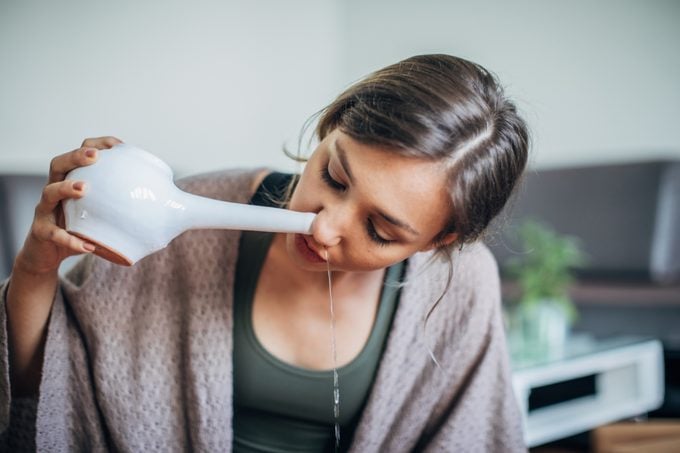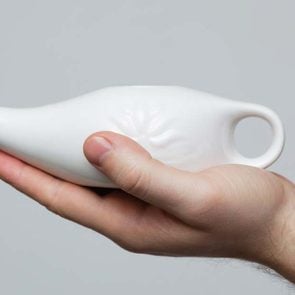How to Use a Neti Pot
Updated: Jun. 21, 2021
Here's what you need to know about using a neti pot to treat or prevent nasal symptoms due to allergies, sinus problems, or a cold.
Our editors and experts handpick every product we feature. We may earn a commission from your purchases.
On This Page
Neti pot 101
Whether or not you have ever used a neti pot, you have likely spotted one in somebody’s house or on a shelf at the pharmacy: a small, somewhat funny-looking, teapot-shaped device with a long spout.
You might already know that people use it for nasal irrigation, or sinus rinsing. But what may come as a shocker: they’ve been used for thousands of years.
Neti pots first originated in ancient Indian Ayurvedic medicine. The term “neti” is actually Sanskrit for “nasal cleansing.”
In recent decades, the technique has become increasingly popular in the United States, likely due to the increasing rates of allergies.
Here’s everything you need to know about how to use a neti pot, the benefits of doing so, and any risks to consider.
What is a neti pot?
A neti pot is a device with a long spout that flushes out your nose, says R. Peter Manes, MD, a Yale Medicine rhinologist and skull-based surgeon and associate professor at Yale School of Medicine.
“There are lots of different nasal irrigation systems,” he says. “People typically lump them together and call them all a neti pot.”
But a true neti pot actually looks like a little teapot, Dr. Manes says.
How does a neti pot work?
While there are many types of neti pots, they all share a common purpose: to flush clogged nasal passages of excess mucus and accumulating debris.
Delivering saline into the nasal passages also helps moisten your nose, explains Dr. Manes.
“It helps treat congestion, colds, allergies in such a way that you are clearing out your nose and clearing out mucus and allergens,” he says.
Types of nasal irrigation systems
A true neti pot is teapot shaped, complete with a handle, spout, and lid.
Other nasal irrigation systems include squeeze bottles, powered irrigation devices, bulbs, syringes, and even battery-operated pulse devices. According to Dr. Manes, they all work similarly to clean nasal passages.
What are the benefits of neti pots?
Using a neti pot can improve your health in a handful of ways, including clearing chronic congestion and improving allergy symptoms. The following are the top benefits of practicing regular sinus rinsing.
It can help improve sinus problems
A randomized control trial of 76 people, published in The Journal of Family Practice in 2002, found that daily saline nasal irrigation improved sinus symptoms and decreased sinus medication use.
Researchers found that 93 percent of people reported overall improvement of sinus-related quality of life.
It can help improve symptoms of upper respiratory tract infections
A 2009 review article published in American Family Physician deemed nasal irrigation an effective supplemental therapy for symptoms of chronic rhinosinusitis, an upper respiratory tract infection.
It also suggested there’s a small amount of evidence sinus rinsing can help viral upper respiratory tract infections.
It may help treat types of rhinitis
The same American Family Physician review article also noted some limited evidence that nasal irrigation may be an effective supplemental treatment for symptoms of irritant rhinitis and allergic rhinitis.
Both conditions cause sneezing, coughing, stuffy or runny noses, and mucus production. Irritant rhinitis is triggered by things in the environment, such as smoke, while allergic rhinitis is triggered by allergens like pollen and dust mites.
It might be useful after surgery
According to the American Family Physician review, there’s some evidence (albeit limited) that nasal irrigation might be effective for postoperative care after endoscopic sinus surgery.
Always check with your doctor before using one after surgery.
What are the risks of using a neti pot?
There are also a few risks of using a neti pot, and some things they can’t help treat.
There is a risk of serious infection
People’s biggest mistake with neti pots is using tap water that is unfiltered or untreated.
The U.S. Food and Drug Administration (FDA) explains that some tap water contains low levels of organisms, including bacteria and protozoa, including amoebas.
While these may be safe to swallow because stomach acid kills them, they can stay alive in your nasal passages and cause potentially serious infections.
Although these types of infections are rare, they can be potentially life threatening, so the type of water you use in your neti pot is incredibly important.
“Only use distilled, sterile, or tap water that has been boiled and cooled,” Dr. Manes says.
You can buy distilled or sterile water in stores.
If you opt to use tap water, boil it for three to five minus and cool it until it’s lukewarm. You can store previously boiled water in a clean, closed container for use within 24 hours.
You can also use water passed through a filter that’s specifically designed to trap potentially infectious organisms.
The label should read “NSF 53” or “NSF 58,” according to the Centers for Disease Control and Prevention. Filter labels that read “absolute pore size of 1 micron or smaller” are also effective.
You may experience ear fullness and irritation
Dr. Manes suggests looking out for ear fullness and irritation, as it can be a side effect of nasal rinsing with a neti pot. Try pouring water more slowly to avoid ear pressure.
Nasal rinsing won’t kill Covid-19
There is limited evidence supporting nasal rinsing as a way to get over a cold, and the World Health Organization warns that saline rinsing will not help prevent respiratory infections, including Covid-19.
Long-term use may be harmful
In 2009, research presented at the annual meeting of the American College of Allergy, Asthma, and Immunology found that long-term use of nasal irrigation may be harmful.
Researchers believe that frequently irrigating the nose depletes its nasal mucosa, an immune blanket of mucus, thereby increasing the risk of recurrent infection.
But keep in mind that this was a research presentation, not a study in a peer-reviewed journal, which is the gold standard for ensuring research quality.

How to make and use a neti pot solution
Dr. Manes explains that there are a lot of different ways to use nasal irrigation devices, depending on the product. Here is how to use neti pots specifically:
- Prepare a saline solution of salt, baking soda, and water. Mix one-half a teaspoon each of baking soda and table salt in 240 ml (about 1 cup) of water that is distilled, sterile, or boiled and cooled. (You can also use premixed sinus rinse packets and follow the instructions.)
- Fill your neti pot with the saline solution.
- Put your head over the sink (or try it in the shower).
- Tilt your head sideways.
- Put the spout into your upper nostril.
- Pour in the liquid. “It will drain through that lower nostril,” explains Dr. Mane.
- Clear your nostrils by gently blowing your nose.
- Reverse the process, tilting your head to the other side.
How often should you use a neti pot?
It’s safe to use a neti pot frequently.
“Some people find that they use it daily and that it’s very helpful, while others use it less frequently,” says Dr. Manes, who usually recommends patients using it one to two times a day, when needed.
“One can certainly overdo it,” he adds. “If you’re using it 40 times a day, that’s pretty extreme.”
Other tips for safe use
It is crucial to use a neti pot correctly to avoid infection. The neti pot safety tips below will ensure you reap the benefits—without the side effects.
Wash your hands before using
It is critical to keep your hands sanitized before using a neti pot, says Dr. Manes.
That will prevent germs from transferring from your skin to the inside of your nose.
Sanitize the device before and after use
In order to avoid contamination, clean the neti pot thoroughly before and after use. Wash it with hot water and antibacterial soap, suggests Dr. Manes.
Dry the device after use
Dry the neti pot with a paper towel after use. Leaving any water in the neti pot could result in bacterial growth.
Only rinse with an appropriate solution
Dr. Manes notes that you should only use a saline solution of typically salt, baking soda, and water.
As we mentioned, you can make it yourself or use premixed packets of ingredients.
Replace your neti pot every few months
If you regularly use a neti pot, replace it every few months to ensure it’s clean and not contaminated.
Do not share your neti pot with others
Avoid sharing your neti pot with others, even your children. That can lead to cross-contamination.
Where can you buy a neti pot?
Neti pots are easy to find and are available without a prescription. You can buy them at CVS, Walgreens, or on Amazon, among other places.
“They are available at many different pharmacies and online,” Dr. Manes points out. “If one does a search for neti pot, they will find one very easily.”
Next, check out these nasal sprays that could help too.



